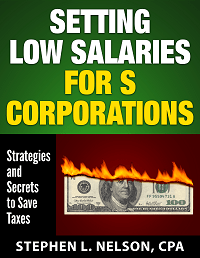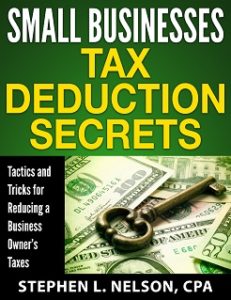
About this time every tax season, as the April 15 deadline fast approaches, newspapers and magazines often run articles about the best tax savings tips you can use for your return.
I find this annual ritual a little humorous, quite candidly. Few good, true, last-minute tax savings opportunities actually exist.
But can I suggest something a little different? How about I tell you about the five best small business tax loopholes I’ve seen this year as I’ve prepared the hundreds of returns our firm delivers.
This information probably won’t help you save taxes on this year’s return. But the information may let you save big money on each and every future year’s business tax return. And the thing is? Now is the time to begin thinking about using these tools…
Wait another year and it’s too late.
Small Business Tax Loophole #1: Elect Subchapter S Status
Do you own a profitable small business? One that pays you not just a reasonable wage but then a nice chunk more?
The very best small business loophole available to you is probably the Subchapter S election.
Too often, accountants discourage their clients from using this loophole. But that’s a shame.
What a Subchapter S election does is allow a regular corporation or a limited liability company to split the business profit into one chunk that is subject to employment taxes and another chunk that is not subject to employment taxes.
The taxes you save? The portion of your profit on which you avoid paying the 15.3% self-employment tax or the 15.3% Social Security and Medicare tax.
Example: A one-owner sole proprietorship operating as an LLC pays roughly a 15% employment tax on his or her profits. On $100,000 of profits, for example, the proprietor pays roughly $15,000 in employment taxes. If the owner makes a Subchapter S election, he or she only pays the 15% tax on the chunk of profits that specifically get called out as wages. If the wages amount equals $40,000, this means the Subchapter S election saves roughly a 15% tax on the other $60,000, or $9,000 annually.
 Tip: I’m rough in my math in the paragraph above to keep the discussion from getting too nitty-gritty, but you can refer to a longer, denser article here.
Tip: I’m rough in my math in the paragraph above to keep the discussion from getting too nitty-gritty, but you can refer to a longer, denser article here.
Also, if you want to really go for it with this gambit, you probably want to get smart about setting the salary of a shareholder employee–something you may want to learn in our “Setting Low Salaries for S Corporations” e-book.
Small Business Tax Loophole #2: Custom-tailored Pension Plan
You know about how a 401(k) plan or tax-deductible Individual Retirement Account works, right?
You put money into one of these accounts and, as long as you follow the rules, you get to deduct your contribution from your taxable income.
Example: You put $10,000 into one of these accounts. You then get to add a $10,000 tax deduction to your tax return, which means you maybe save $2,000 or $3,000 or $4,000 in federal and state income taxes. Over time the money grows. And when you take out the money, you will theoretically get taxed on the withdrawal, but probably at very modest rates.
A pretty good deal, right? I agree. And so the small business retirement plan option counts as my second best small business tax deduction loophole.
If I could make just a handful of observations about the small business angle:
1. While you can use things like IRAs and 401(k) plans if you’ve got a small business, you should know that you also have other great retirement savings plan options available if you’re a business owner. These other options use different formulas and often produce very large deduction amounts. Even as much as $50,000 or $100,000 a year. (Check out this long-ish article I did about pension plan options available for S corporations if you want more information.)
2. Something like a pension plan can make it easier to save money with an S corporation election because you can have the S corporation treat the pension contribution as a deduction.
3. You need to be cautious about the discrimination rules when you set up a small business pension plan. (The general rule is, “don’t hurt your employees,” but the specifics of this general rule are complicated so be sure you understand the specifics of whatever you choose.)
Small Business Tax Loophole #3: Avoiding (or Severing) State Tax Nexus
Here’s a question: Have you ever thought a particular state hits you or your business with too heavy a tax burden?
If you answer this question “yes,” you should know that it’s often possible to either avoid state tax nexus or to sever state tax nexus and then simply not pay income taxes to the state.
You probably need to consult a tax accountant for help doing this, but the basic principle to understand is multistate apportionment.
In a nutshell, states look at the property, payroll and sales you have within a state to determine first if you owe them income taxes and then, if you do owe them taxes, to apportion a chunk of your profit to the state so they can tax it.
You can therefore avoid state income taxes by avoiding owning property in a state, by avoiding having employees or independent contractors in a state, and by avoiding having sales in a state.
The weird part about this is, some employees who reside and get paid in another state don’t create nexus. And some sales in another state don’t actually count as sales in that other state.
For one example, federal law says a state can’t say you’ve got nexus if you’ve got a sales person merely soliciting orders for sales of personal property.
And here’s another example: You having a customer in another state doesn’t mean necessarily that you have a sale in another state. If you ship the product from your home state location and don’t do anything else in the other state, your home state may get to count the sale.
A related point about state income taxes: If you understand the simple mechanics that states use for apportionment, you may be able to game the apportionment formula and thereby allocate more income to states with lower tax rates. (Check out the section labeled “State Taxation of Corporations” in this blog article if you’re interested in how the usual multistate apportionment works.)
Small Business Tax Loophole #4: Family Income Splitting
High-income small business owners have a couple of additional tax loopholes worth knowing about—and maybe considering.
Here’s the first loophole: family income splitting.
Family income splitting works because a successful small business owner’s last dollars of income may be taxed at very high rates. Furthermore, this taxpayer often loses tax credits, common write-offs (such as rental deductions), itemized deductions and even personal exemptions.
If, however, the small business employs family members, income shifts from a high-marginal-rate taxpayer who probably doesn’t get any credits or as many deductions to a low-marginal-rate or medium-marginal-rate taxpayer who does.
Again, the technique of family income splitting doesn’t make sense for most people. But, hey, if you’re a high marginal rate business owner, look at the option of paying family members generously for the work they perform.
Example: If you pay your son or daughter $20,000 and he or she uses this income to live and attend school, you may find that you’ve saved paying a 40% or more income tax rate… Further, your son or daughter may not only pay a 5% tax rate, he or she may enjoy tax credits that wipe out or more than wipe out this income and payroll tax liability.
Small Business Tax Loophole #5: Obsessive Organized Deduction Seeking
One last, final tip regularly shows its strength on the occasional small business owner’s tax return: getting really obsessively organized about tax deductions.
Quite honestly? This loophole is probably the least attractive of the five mentioned here.
Not, mind you, because the loophole is weak. But rather because using the loophole requires more upfront work and more ongoing maintenance than most small business owners have time for.
All that said, if you want to keep good records of both your in-office and out-of-office business activities, if you’re willing to run your life and your family member’s lives in a way that means you’re always passing the deductibility tests for business tax deductions, you can add thousands and maybe tens of thousands of dollars in deductions to a business income tax return.
Let me be clear: I’m not saying you can claim personal expenses as business deductions. You can’t. But if you want to bad enough, you can bump up your business deductions.
Example: A domestic vacation can often easily be turned mostly into a deductible business travel expense by passing the tests for business travel. You just need to make sure that more than 50% of your work days are used for valid business activities—such as attending a convention.
Example: College or graduate school costs of a business owner or family employee can often easily be turned into deductible business expenses by making sure that the education counts as valid employee training.
Example: This is pretty tangential, but if you’re a horse owner reading this, let me also reference a blog post I did for my daughter’s blog, Red Raven Equine. It describes how someone turned horse-related expenses into business deductions.
 Tip: Federal and state tax laws provide small businesses with dozens of powerful tactics for cutting taxes.
Tip: Federal and state tax laws provide small businesses with dozens of powerful tactics for cutting taxes.
But you need to know the rules and carefully arrange your finances.
If you want help or more information about how to take advantage of these “secrets hidden in plain sight,” consider our popular downloadable ebook “Small Businesses Tax Deduction Secrets“.
Repeating Myself
I’ve still got scads of tax returns to finish up, so I won’t chatter on here.
But let me as I close repeat something I said in the opening paragraphs: You can save substantial amounts on your business tax return by exploiting a handful of legal loopholes. But you need to look forward to the 2015 return and not backwards to the 2014 return that’s due in a few days. The big tax saving opportunities available to you relate to the future and not the past.
Great ideas Steve, one thing most taxpayers don’t think about and many tax practitioners don’t push enough is retirement funding.
Many have big chunks of cash sitting in non retirement accounts and simply reclassifying funds into seps, simples of solo 401K’s can save a lot of tax.
Personally i’m a big fan of Roth 401K’s, no deduction now but no tax consequence in the future that is till the IRS changes to code to place an excise tax on all Roth distributions somewhere down the road.
More importantly, retirement accounts provide great asset protection.